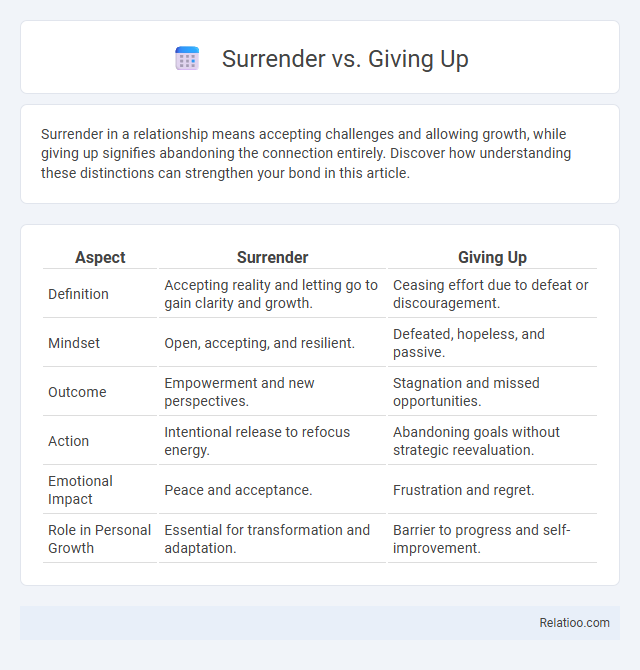Surrender in a relationship means accepting challenges and allowing growth, while giving up signifies abandoning the connection entirely. Discover how understanding these distinctions can strengthen your bond in this article.
Table of Comparison
| Aspect | Surrender | Giving Up |
|---|---|---|
| Definition | Accepting reality and letting go to gain clarity and growth. | Ceasing effort due to defeat or discouragement. |
| Mindset | Open, accepting, and resilient. | Defeated, hopeless, and passive. |
| Outcome | Empowerment and new perspectives. | Stagnation and missed opportunities. |
| Action | Intentional release to refocus energy. | Abandoning goals without strategic reevaluation. |
| Emotional Impact | Peace and acceptance. | Frustration and regret. |
| Role in Personal Growth | Essential for transformation and adaptation. | Barrier to progress and self-improvement. |
Understanding the Difference: Surrender vs Giving Up
Surrender involves accepting a situation with conscious awareness and choosing to release control, whereas giving up implies quitting due to defeat or hopelessness. Understanding the difference helps you recognize that surrender is a powerful act of letting go, often leading to growth or transformation, while giving up can stagnate progress and diminish resolve. Embracing surrender allows your mindset to shift toward acceptance and strategic adaptation instead of resignation.
Defining Surrender: Acceptance Without Defeat
Surrender is defined as a conscious acceptance of reality without resistance, recognizing circumstances beyond control without perceiving it as defeat. Unlike giving up, which implies quitting due to discouragement, surrender involves a mindful release of struggle while maintaining inner strength and clarity. This acceptance fosters resilience by allowing individuals to adapt and find peace in challenging situations rather than succumbing to hopelessness.
The Psychology Behind Giving Up
Giving up often stems from psychological factors such as fear of failure, low self-esteem, and perceived lack of control, leading individuals to abandon goals prematurely. Surrender involves a conscious and intentional acceptance of circumstances, reflecting emotional resilience and a strategic shift rather than defeat. Understanding these distinctions aids in developing healthier coping mechanisms and fostering mental strength in the face of challenges.
Emotional Impact: Surrender vs Giving Up
Surrender involves a conscious acceptance of circumstances, often leading to emotional relief and inner peace, whereas giving up reflects a sense of defeat that can trigger feelings of frustration and despair. The emotional impact of surrender is typically reclaiming control through acceptance, fostering resilience and growth, while giving up frequently results in emotional stagnation and loss of motivation. Understanding this distinction helps clarify how surrender can be a proactive, healing choice, contrasting with the negative emotional consequences of giving up.
Surrender as a Path to Growth
Surrender as a path to growth involves consciously letting go of resistance and control, allowing you to embrace change and unlock new opportunities for personal development. Unlike giving up, which often stems from defeat or hopelessness, surrender is an empowered choice that fosters resilience and deeper self-awareness. Your willingness to surrender creates space for transformation and accelerated growth in both mindset and life experiences.
The Consequences of Giving Up
Giving up often leads to missed opportunities and stagnation, negatively impacting your personal growth and long-term success. In contrast, surrender involves accepting circumstances with clarity and intention, allowing you to reassess and redirect your efforts effectively. Understanding these differences helps you avoid the destructive consequences of giving up while embracing surrender as a strategic choice for resilience.
When Surrender Leads to Empowerment
Surrender leads to empowerment when it involves consciously releasing control and accepting reality, creating space for growth and resilience. Unlike giving up, which implies defeat and resignation, surrender is an active choice that fosters clarity and inner strength. Empowerment arises as surrender allows individuals to redirect energy towards constructive action rather than futile resistance.
Overcoming the Stigma of Letting Go
Surrender involves consciously releasing control to embrace acceptance, while giving up implies defeat and loss of hope, often burdened by societal stigma. Overcoming the negative perception of letting go requires recognizing surrender as an empowering act of resilience and growth rather than weakness. Embracing vulnerability through surrender fosters mental clarity and emotional freedom, transforming personal setbacks into opportunities for renewal.
Signs You’re Surrendering, Not Giving Up
Recognizing the signs you're surrendering, not giving up, involves an acceptance of circumstances beyond your control while maintaining inner peace and clarity. Your mindset shifts from resistance to openness, allowing for growth and new possibilities rather than abandonment of goals or responsibilities. This conscious release reflects strength and wisdom, promoting resilience instead of defeat.
Choosing Surrender Over Giving Up: Practical Steps
Choosing surrender over giving up involves embracing acceptance and mindful release rather than resignation. Practical steps include acknowledging limitations without self-judgment, shifting focus from resistance to adaptation, and cultivating patience through meditation or reflective journaling. This approach fosters resilience by redirecting energy from futile struggle to constructive growth and clarity.

Infographic: Surrender vs Giving Up
 relatioo.com
relatioo.com